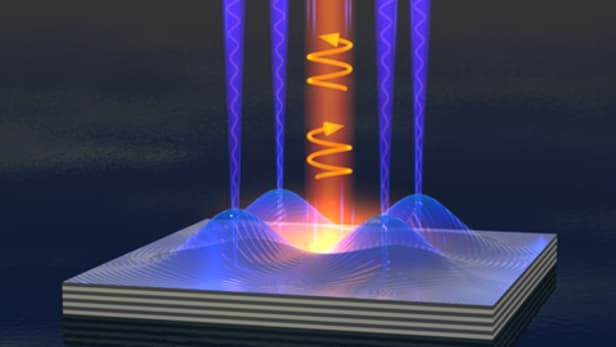Scientists at the University of Cambridge have used a liquid light to create a semiconductor switch that’s tiny enough to blur the distinction between light and electricity while also enabling the development of much faster and smaller electronic components.
With the demand for faster, small electronics on the rise, and microelectronics reaching the point where quantum effects are challenging the use of electrons as a transporter of data, researchers across the globe are exploring ways to solve these issues.

To create a Polariton Bose-Einstein condensate, laser light is captured between mirrors in a microcavity that’s a few microns in size. Image source: University of Cambridge.
Instead of going about the contemporary methods used to convert between electrical signals and optical ones considered inefficient, the research team believes it’s better to remove the middleman and blend the two together. To achieve this, the researchers created a switch using a new state of matter called Polariton Bose-Einstein condensate to combine electric and optical signals while consuming small quantities of energy in the process.
“The polariton switch unifies the best properties of electronics and optics into one tiny device that can deliver at very high speeds while using minimal amounts of power,” said Dr. Alexander Dreismann of Cambridge's Cavendish Laboratory.
In order to create a Polariton Bose-Einstein condensate, laser light is captured between mirrors in a microcavity that’s a few microns in size. This is where the light interacts with thin sections of semiconductor material to produce a half-light, half-matter combination of quasi-particles known as polariton, which are made of semiconductor excitons and photons.
If a large portion of polaritons are generated at once in a confined space, they often clump together and condense like water vapor does when encountering a cool surface. The light-matter fluid that forms at during this process is imparted with a particular spin, where it can spin clockwise (up) or anti-clockwise (down). To make the direction of spin controllable, making it usable in an electronic context, the team induced an electric field within the condensate, making it possible to switch between up and down states at will. As the polariton fluid produces light as it rotates, the researchers believe that spin encoded light could convert electrical data to optical signals that can be sent through optical fibers.
The results of this research were published in the journal Nature Materials.
Advertisement
Learn more about Electronic Products Magazine





